Imagine it’s spring 2002. Word has spread of a second theme park added to the Disney resort outside of Paris. As the train pulls into the Marne-la-Vallée – Chessy station, you’re bound to notice a few changes, especially if you haven’t visited the resort since its debut a decade earlier.
For one thing, Disney has tinkered with some naming conventions. EuroDisneyland at the Euro Disney Resort is now Disneyland Park at Disneyland Paris. The name change, according to Michael Eisner, is because “[a]s Americans, the word ‘Euro’ is believed to mean glamorous or exciting. For Europeans it turned out to be a term they associated with business, currency, and commerce. Renaming the park Disneyland Paris was a way of identifying it with one of the most romantic and exciting cities in the world.” (In fact, the resort would have twelve distinct name & logo changes in 25 years!)

In addition, the “Downtown Disney” style shopping area once called Festival Disney has become the Disney Village.
One thing that hasn’t changed? Disneyland Paris still has seven resort hotels – the same seven that opened together on April 12, 1992. It’s no secret that in the decade since opening, Disneyland Paris has been… well… cooly received. Hotel occupancy has stayed disappointing, and while Disney Parks fans call the Parisian park the most detailed, thoughtful, and well-designed Disney’s ever built, that hasn’t gotten locals through the gates.
Maybe a second theme park will!
When Walt Disney World began adding new theme parks, it simply placed them on vacant plots dotted around the 40 square-mile property. When the original Disneyland in California added a second gate, it took a little more work. Disneyland wasn’t designed with a second park in mind, so the company needed to purchase land, reroute roads, build new parking structures, and buy existing hotels to turn their solitary theme park into a “resort.”
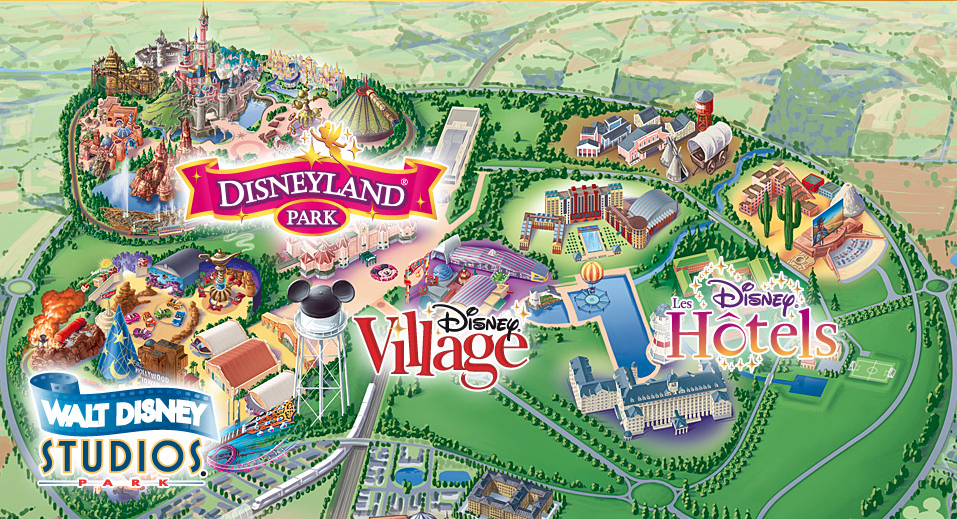
Disneyland Paris – while much, much smaller than Walt Disney World – was master-planned and laid out intentionally. From the start, it was designed for multiple parks. Disney even announced the Disney-MGM Studios Europe that would fit perfectly into a plot of land branching off of the central plaza. But the financial failure here hit Disney hard, and executives became infamously wary of large-scale expansions. So instead of the Disney-MGM Studios Europe, Disneyland Paris’ second park is Walt Disney Studios Park. And from the outside, it doesn’t look too shabby!
The entrance to Walt Disney Studios is an elegant studio arch, clearly modeled after the ornate arches that often mark the properties of Hollywood’s elite studios. A wide plaza beyond is in the shadow of three large soundstages, at least lovingly dressed with Golden Age-style arches and architectural flourishes instead of being drab boxes. Presiding over them all is a sight familiar to Walt Disney World visitors of the ’90s and 2000s: the Earffel Tower.
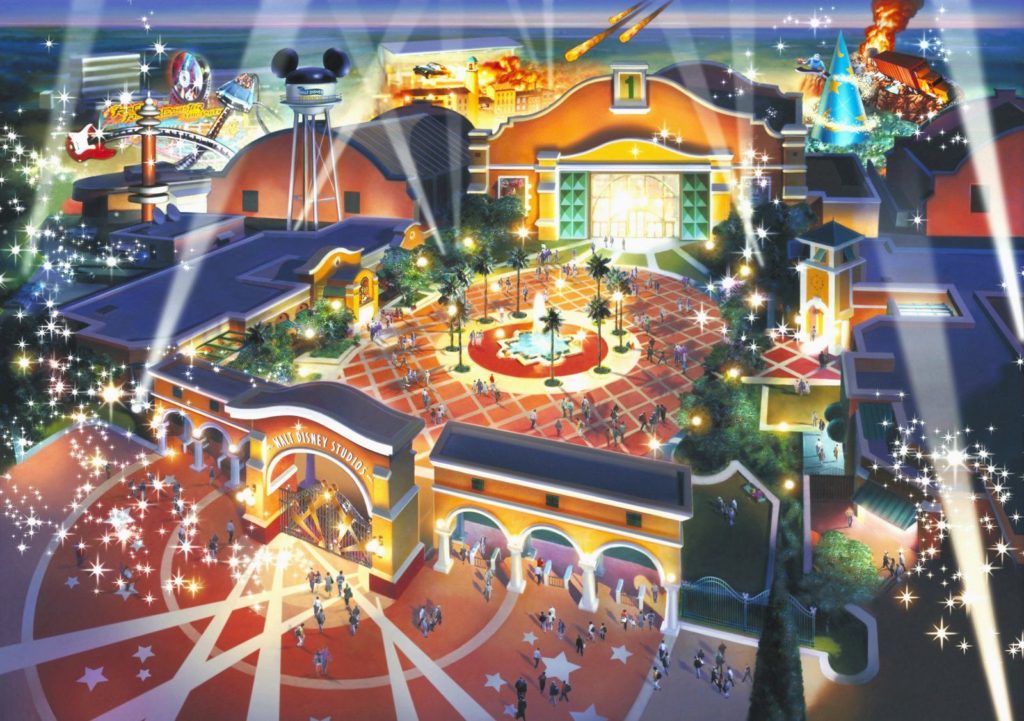
This comical landmark – a 163-foot tall water tower wearing Mickey Mouse ears – is the park’s de facto icon. Like its older (and shorter) sister in Florida, the water tower is meant to evoke early 20th century studio backlots, where such water towers were kept on property at all times to douse any on-set fires on the very flammable wooden sets of the day. The Earffel Tower in Florida made it to our list of demoted and destroyed park icons, but in Paris, the tower still stands as the park’s signature sight.
A fountain in the center of this plaza showcases Mickey Mouse as he appeared in the “Sorcerer’s Apprentice” segment in the 1940 film Fantasia. It also marks the entrance to the park’s unique opening act…
Front Lot – Studio 1
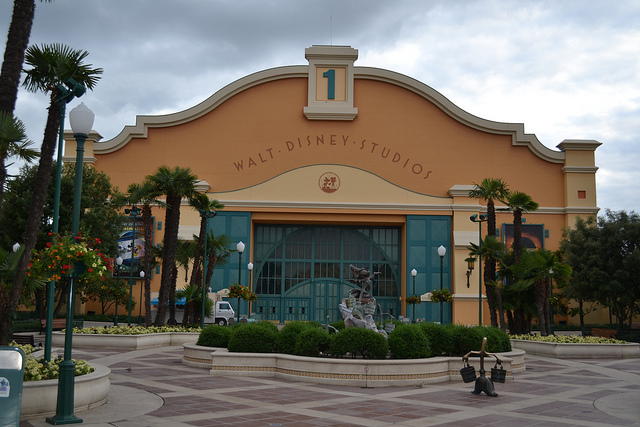
The industrial teal gates of this towering central soundstage – Studio 1 – are pulled back, ushering guests into the park’s “Main Street.” The original plans for Disney-MGM Studios Europe had called for an enclosed version of the Floridian park’s Hollywood Blvd. That’s kind of what Walt Disney Studios has to offer.
But while Main Street, Buena Vista Street, and Hollywood Blvd. feel like idealized, magical, living replicas of romantic real places, Studio 1 borrows instead from the motif Disney was using in the 1990s and early 2000s at Disney’s California Adventure and Hong Kong Disneyland – cheap, cheerful, and flat.
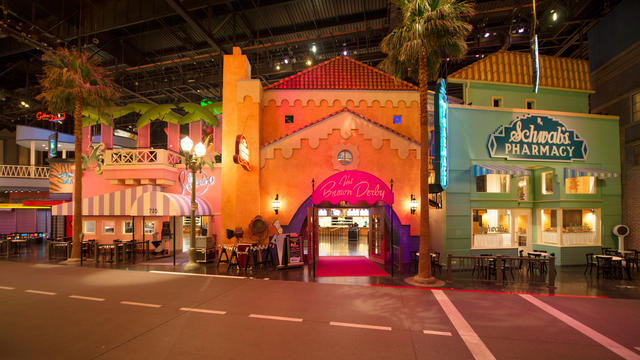
Day-glo colors, flat facades, exposed lighting rigs, neon lights reflecting from the visible corrugated steel ceiling, and wooden barricades around props make it clear that this is not a historic Hollywood. It’s a Hollywood set of Hollywood. Make no mistake: you’re standing in a massive soundstage (indeed, look around – you’ll see the walls and ceiling) with flat painted panels giving the “illusion” that the street stretches onto infinity.
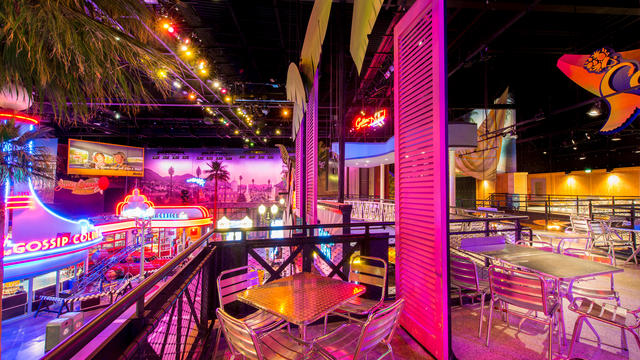
In the spirit of Disney’s California Adventure before it, the time is now and the place is here! This is a Hollywood of today, with metal patio tables and chairs, cameras hoisted on rigs, people passing by on overhead suspended catwalks, and facades that give way to structural supports.
It’s hyper-saturated; an over-the-top pastiche of what it must be like on a high-energy, comical movie set. Yet despite the way it drips in stylization, Studio 1 doesn’t inspire much imagination. But hey, if this park is meant to be a studio where we get to see “behind the scenes,” then that’s alright! No imagination needed.
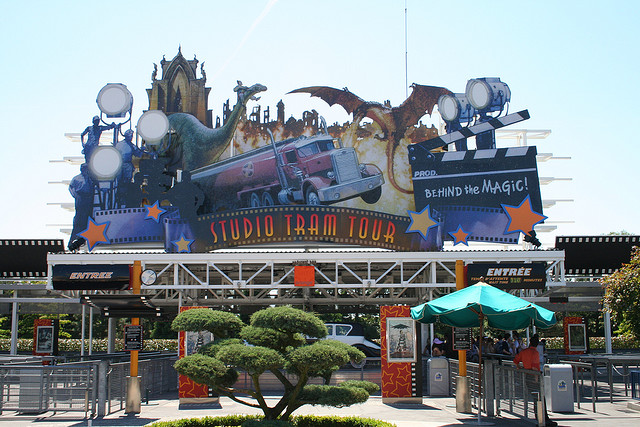
Exiting out into daylight once more, you’ll be standing in the park’s center – its “hub.” However, there’s no “Great Movie Ride” directly ahead. In fact, the awkward, open plaza dead-ends in a garish, industrial attraction marquee meant to look like a giant clap board with flat dragons, camera riggings, and painted flames coming out. Adorned with dragons and dinosaurs, the marquee for the park’s Studio Tram Tour suggests that this will be a high-energy, in-your-face headliner for the park. As a result, we’ll save it for later.
Anyway, standing at that central “hub” just outside of Studio 1, you can look to the left. Look to the right. From this vantage point, you can see literally everything else in the park. Walt Disney Studios doesn’t have many “nooks and crannies” to explore. After all, this is a studio lot! Instead, you’ll find large, open, expansive plazas bordered by tan showbuildings. You’re not in any particular “place” or “time.” You’re… in a studio!
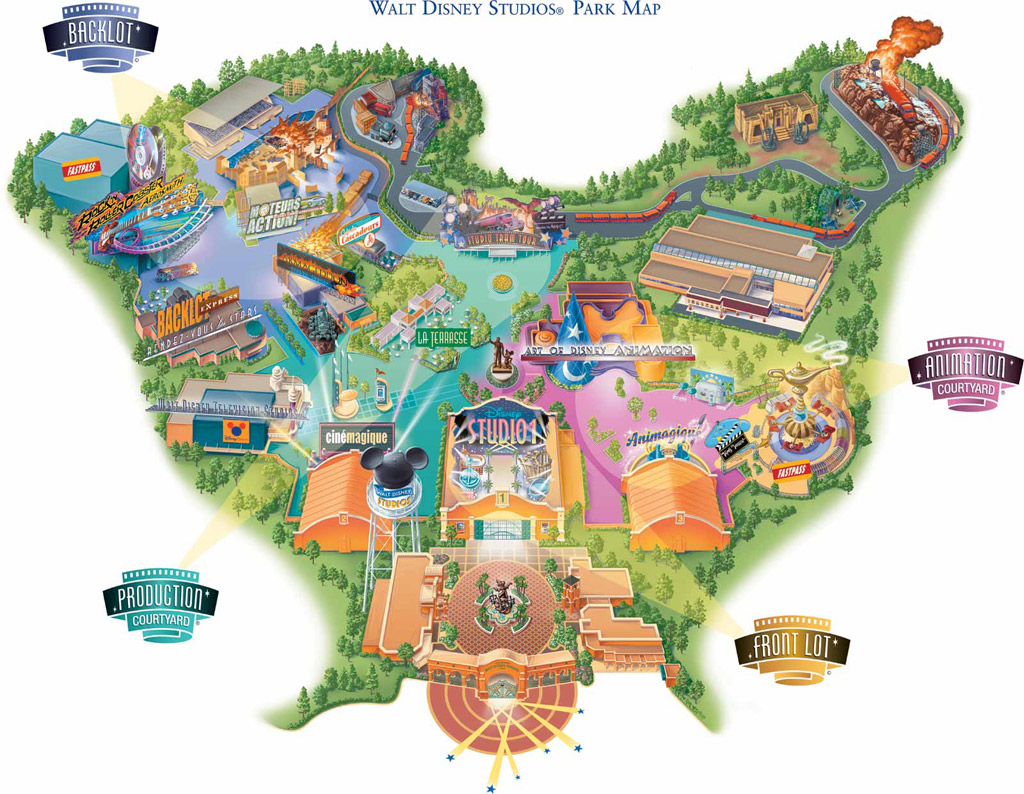
The park’s layout is somewhat like the letter Y. Studio 1 serves as the letter’s stem. Now, we need only explore the two arms. First, let’s turn to the right and enter the park’s first land.
Animation Courtyard
Just a few steps and you’re there! Animation Courtyard is a celebration of Disney’s rich history of animated films up to this summer’s upcoming release, Lilo & Stitch. Okay, okay, so technically, Disney Animation has begun what will be a decade-long lull, churning out DreamWorks-chasing animated films that don’t connect with audiences – things like Treasure Planet, Dinosaur, Home on the Range, Chicken Little, and Meet the Robinsons.
Given that, it might’ve been smart to turn back the clock here; to create an animation-themed land that recreates Walt’s studio on Hyperion Ave., with odes to Snow White, Pinocchio, Peter Pan, and other classics. But… nope.
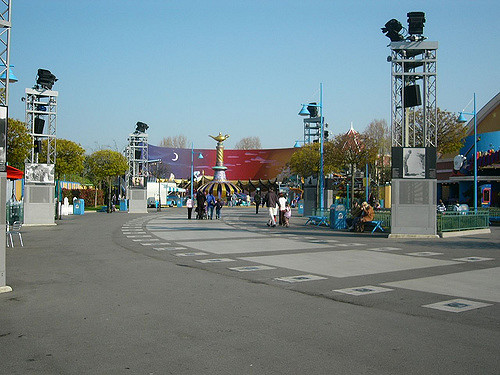
Instead, Animation Courtyard is a stunning desolate place. There’s blacktop asphalt as far as the eye can see, with towering lighting rigs and industrial backstage elements. In Leslie Iwerks’ The Imagineering Story, now-Chief Creative Officer of Walt Disney Imagineering recalled his visit to the park:
The first time I went to Paris’ second gate, it was after hours. No kidding, for the first time minutes, I’m walking through and I’m like, “When are we gonna be in the park?” And he turned to me and he goes, “You’re in the park.” And I’m like, “I’m on stage?” He goes, “You’re on stage.”
Like, this looks backstage. It’s a bunch of gray warehouses. He goes, “Yeah, it’s supposed to be like a studio.” But again, it was this notion of, ‘Ah, the people – the guests will buy it. This is what a studio really looks like. The guests, they just want…. you know…”
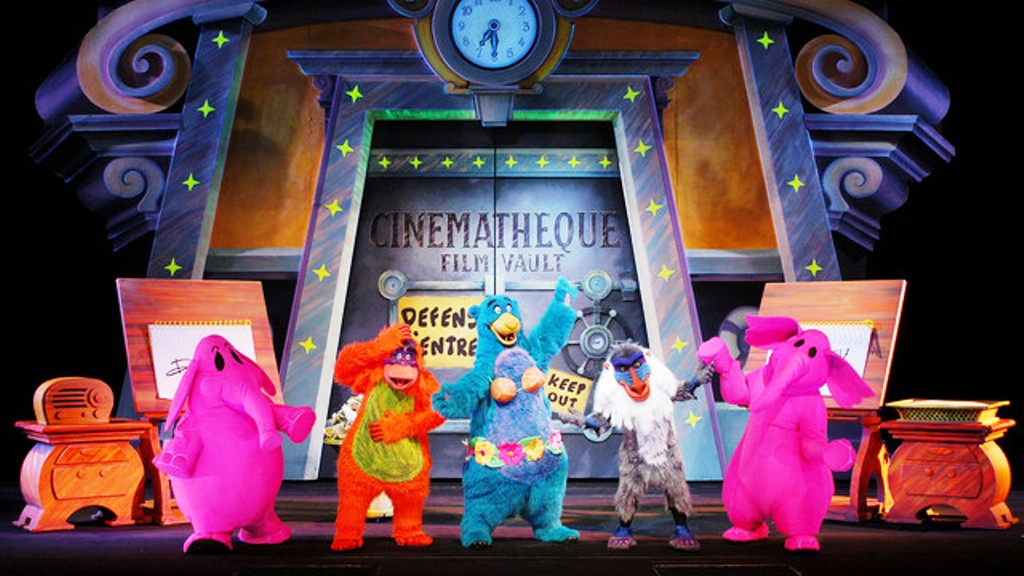
It’s star attraction is probably the stage show hosted in Studio 3, one of the large soundstages that borders Studio 1. Animagique is a live-action stage show incorporating puppets, inflatables, blacklight, and more as Donald Duck unlocks the Disney Vault and unleashes the worlds of The Jungle Book, Winnie the Pooh, The Lion King, and The Little Mermaid. It’s a fan favorite.
In addition, Animation Courtyard is home to The Art of Disney Animation featuring the Animation Academy, similar to the larger animation attractions at Disney’s Hollywood Studios and Disney California Adventure, and Flying Carpets Over Agrabah.
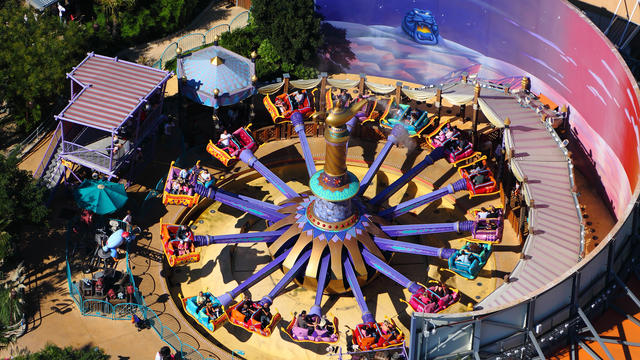
As you might imagine, this is a unique twist on Magic Kingdom’s Magic Carpets of Aladdin. But here, instead of being in an Arabian courtyard decked out with golden camels, palm trees, and a bubbling oasis, you’re on a movie set circling over a concrete pad with a wrapped backdrop painted in vivid colors. Genie’s here, too, hoisted up in a production chair shouting out your cue through a bullhorn. Wait a second… you thought Aladdin and Jasmine were really flying? Or, even sillier, that you could, too? Ha! Keep dreamin’! Isn’t seeing “behind the scenes” fun?
In any case, we have to move on. Animation Courtyard is a dead-end (in more ways than one) and its three attractions (and one ride) don’t elevate it quite to the level of any of next-door Disneyland Paris’ intricate, themed lands.
Production Courtyard
Passing back through the park’s “hub,” we enter the first “themed” land on the left arm of the “Y.” Production Courtyard leaves the world of animation behind in favor of live action. Fittingly, Studio 2 – the mirrored soundstage opposite Studio 3’s Animagique – is playing Cinémagique. Think of it as the Great Movie Ride tweaked for European audiences and put in stageshow form.
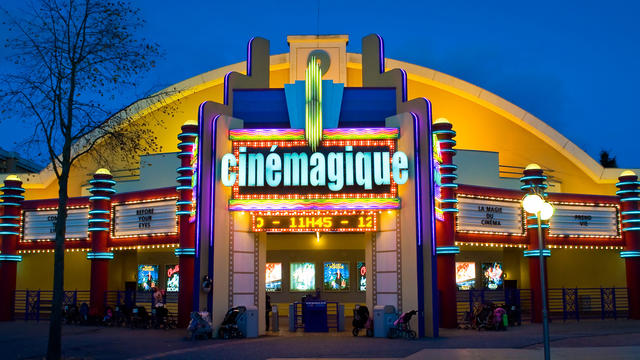
In fact, Cinémagique may be one of the best shows in Disney’s playbook. Cast as a boring retrospective on films from the silent age to modern blockbusters, the show quickly rerails as a member of the audience (played a live actor) is magically transported into the screen and whisked through a cinematic landscape from Safety First! and Some Like it Hot to Star Wars and The Wizard of Oz, stumbling upon everything from Monsters Inc. to The Exorcist along the way.
The would-be star of Production Courtyard, though, is the ride intended to be the park’s headliner: Studio Tram Tour: Behind the Magic. Modeled after the Disney-MGM Studios ride (which is in turn based on the Universal Studios Hollywood original), Paris’ version of the Tram Tour may be the worst Disney ride of the 21st century (so far), given that the Parisian park at no time even attempted to be a real movie studio.
Instead, the Tram Tour passed by musty, rotting, would-be props set haphazardly in lawns along the side of the roadway that give the impression that they might have been used in films, by some ambiguous “sets” littered with cameras and dollies, by numerous camera-ready vehicles of all shapes and sizes, and through two staged events. The first is a trip through Catastrophe Canyon (borrowed from Florida) followed by a tour of its backstage reveal.
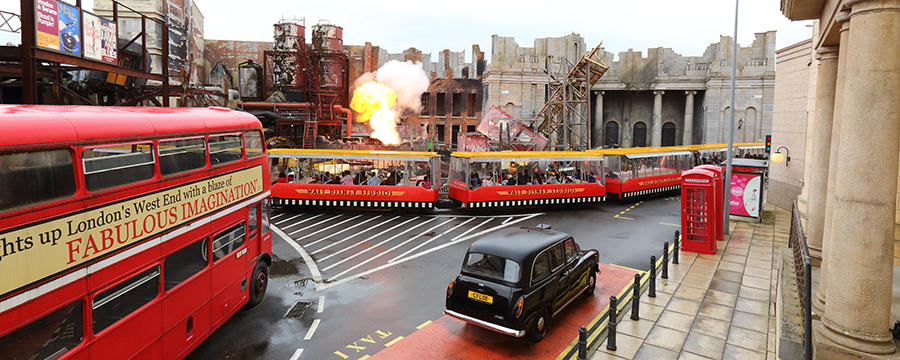
The second staged encounter is a tour of the “set” of Touchstone’s largely-forgotten 2002 box office bust Reign of Fire (which was actually filmed in Ireland) displaying a future London wrecked-and-ruined by dragons, including a physical effects display with a flamethrower.
As quickly as it began, the Studio Tram Tour is over, and with it, Production Courtyard.
Backlot
The most ominously-named of the park’s themed “lots” is the Backlot, where designers were able to dispense with any indication whatsoever that they were trying to theme the park. Instead, the Backlot can have exposed steel, unthemed showbuildings, industrial signage, and more. Its three attractions similarly ensure that any pretense of story is quickly disposed of.
First, a familiar sight for Disney World visitors – Rock n’ Roller Coaster avec Aerosmith. Though here on the Backlot, the attraction does away with any insinuation that you’re visiting a recording studio and even with the razor-thin plot of racing through Hollywood to attend a premier.
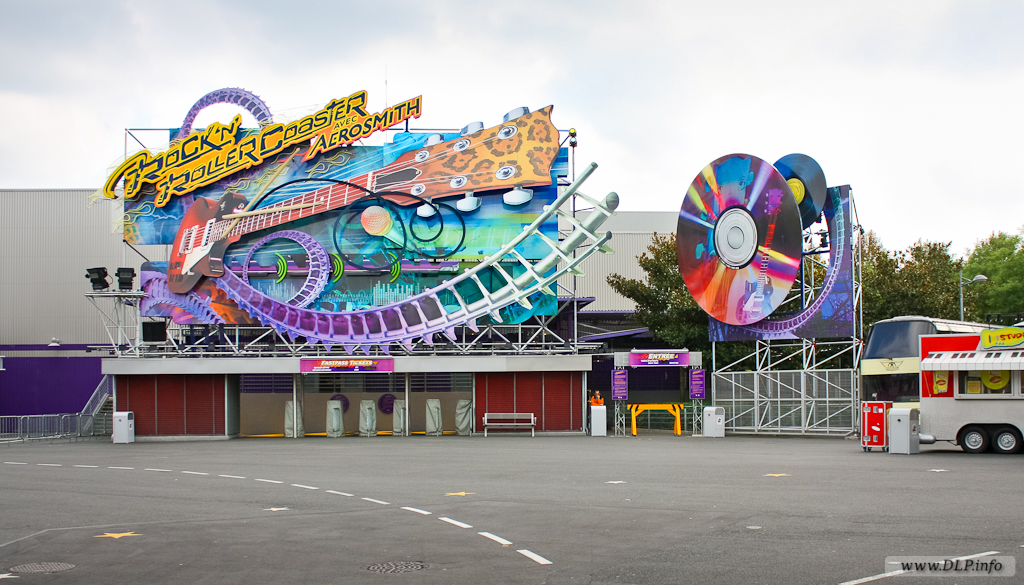
Ironically, dropping the bulk of the “race through Hollywood” storyline ended up benefitting Paris’ version of the ride. While the track layout is identical to Orlando’s, the ride instead takes place in an abstract space of spinning, flashing, undulating lights that give the ride an astounding element.
The intricate and ambitious light show that occurs around riders has to be seen to be believed, and you can watch it take place here. The more abstract style actually holds up better than the blacklight cartoon-perspective of Orlando’s. (So for the first time yet, advantage: Paris?)

Here in the Backlot, you’ll also find the Moteurs… Action Stunt Show Spectacular. The ambitious (if brainless) stunt car show actually made its debut in Paris, before being duplicated at Disney’s Hollywood Studios in Florida in 2005 (where it’s already come and gone, closed to make way for Star Wars: Galaxy’s Edge).
Already, we’ve arrived at the park’s final inhabitant: Armageddon – Les Effets Speciaux. As the name implies, we’re here to get an insider’s perspective of the special effects that powered the 1998 Jerry Bruckheimer film for Touchstone Pictures, Armageddon. Similar in style and scope to Universal’s “Twister… Ride It Out!” this living demonstration puts guests within feet of fireballs, sparks, steam, flickering lights, and an asteroid that seems to destroy all life on Earth until… “CUT!”
Honestly imagine: you’re seeing the whole park in the Member-exclusive view of the architectural model above!
At just about 25 developed acres, Walt Disney Studios is by far the smallest Disney Park on Earth. But what’s worse, its miniscule attraction offerings include just three – yes, three! That’s trois! One, two, three – rides. And remember, they’re the Magic Carpets of Aladdin, the Studio Tour, and Rock ‘n’ Roller Coaster. Next door, Disneyland Paris includes as much to do in Frontierland alone. And yet, this brand new Disney park meant to salvage Disneyland Paris seemed poised to do more harm than good… What happened next? Read on…



